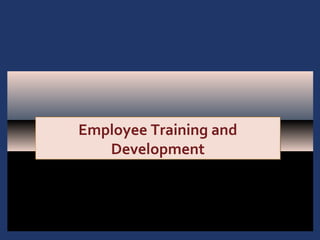
Introduction to employee training and development ppt 1
- 1. 1 - 1 Employee Training and Development Employee Training and Development
- 2. 1 - 2 Introduction: Training for Competitive Advantage Introduction: Training for Competitive Advantage
- 3. Objectives After reading this chapter, you should be able to: 1. Discuss the forces influencing the workplace and learning, and explain how training can help companies deal with these forces. 2. Discuss various aspects of the instructional system design model. 3. Describe the amount and types of training occurring in various companies. 1 - 3
- 4. Objectives (continued) 4. Discuss the key roles and competencies required for training professionals. 5. Identify appropriate resources (e.g., journals, websites) for learning about training research and practice. 1 - 4
- 5. What is training? Training refers to a planned effort by a company to facilitate employees’ learning of job-related competencies. The goal of training is for employees to master the knowledge, skill, and behaviors emphasized in training programs, and apply them to their day-to-day activities 1 - 5
- 6. Training Design Process 1 - 6 Conducting Needs Assessment Ensuring Employees’ Readiness for Training Creating a Learning Environment Ensuring Transfer of Training Developing an Evaluation Plan Select Training Method Monitor and Evaluate the Program
- 7. Assumptions of Training Design Approaches Training design is effective only if it helps employees reach instructional or training goals and objectives. Measurable learning objectives should be identified before training. Evaluation plays an important part in planning and choosing a training method, monitoring the training program, and suggesting changes to the training design process. 1 - 7
- 8. Forces Influencing the Workplace and Training Globalization Need for leadership Increased value placed on knowledge Attracting and winning talent Quality emphasis Changing demographics and diversity of the work force New technology High-performance model of work systems 1 - 8
- 9. Core Values of Total Quality Management Methods and processes are designed to meet the needs of internal and external customers. Every employee in the company receives training in quality. Quality is designed into a product or service so that errors are prevented from occurring, rather than being detected and corrected. 1 - 9
- 10. Core Values of TQM (continued) The company promotes cooperation with vendors, suppliers, and customers to improve quality and hold down costs. Managers measure progress with feedback based on data. 1 - 10
- 11. Skills needed to manage a diverse work- force include: Communicating effectively with employees from a wide variety of backgrounds. Coaching and developing employees of different ages, educational backgrounds, ethnicities, physical abilities, and races. Providing performance feedback that is free of values and stereotypes based on gender, ethnicity, or physical handicap. Creating a work environment that allows employees of all backgrounds to be innovative. 1 - 11
- 12. How Managing Cultural Diversity Can Provide Competitive Advantage 1. Cost argument As organizations become more diverse, the cost of a poor job in integrating workers will increase. Those who handle this well will thus create cost advantages over those who don’t. 2. Resource- acquisition argument Companies develop reputations on favorability as prospective employers for women and minorities. Those with the best reputations for managing diversity will be the most attractive employers for women and minority groups. An important edge in a tight labor market. 3. Marketing argument The insight and cultural sensitivity that members with roots in other countries bring to the marketing effort should improve these efforts in important ways. 1 - 12
- 13. How Managing Cultural Diversity Can Provide Competitive Advantage (continued) 4. Creativity argument Diversity of perspectives and less emphasis on conformity to norms of the past should improve the level of creativity. 5. Problem-solving argument Heterogeneity in decisions and problem-solving groups potentially produces better decisions through a wider range of perspectives and more through critical analysis of issues. 6. System flexibility argument An implication of the multicultural model for managing diversity is that the system will become less determinant, less standardized, and therefore more fluid. The increased fluidity should create greater flexibility to react to environmental changes (i.e., reactions should be faster and cost less). 1 - 13
- 14. Use of new technology and work design needs to be supported by specific HRM practices: Employees choose or select new employees or team members. Employees receive formal performance feedback and are involved in the performance improvement process. Ongoing training is emphasized and rewarded. Rewards and compensation are linked to company performance. 1 - 14
- 15. Use of new technology and work design needs to be supported by specific HRM practices: (continued) Equipment and work processes encourage maximum flexibility and interaction between employees. Employees participate in planning changes in equipment, layout, and work methods. Employees understand how their jobs contribute to the finished product or service. 1 - 15
- 16. Roles and Competencies of TrainersRoles Competencies Analysis/Assessment Role Industry understanding; computer competence; data analysis skill; research skill Development Role Understanding of adult learning; skills in feedback; writing, electronic systems, and preparing objectives Strategic Role Career development theory; business understanding; delegation skills; training and development theory; computer competence Instructor/Facilitator Role Adult learning principles; skills related to coaching, feedback, electronic systems, and group processes Administrator Role Computer competence; skills in selecting and identifying facilities; cost-benefit analysis; project management; records management 1 - 16
Notas do Editor
- See Figure 1-1 on page 6 for details
- See Table 1-1 on page 8 for details
- See Table 1-3 on page 19 for details
- See Table 1-3 on page 19 for details
- See Table 1-6 on page 28 for details
